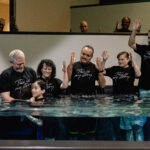 [1]
[1]
A collegiate church plant in the h2o Ohio network. Photo courtesy of h2o Church/SCBO.
Over the last seven years, the Ohio Southern Baptist collegiate ministry system has grown from 250 actively engaged college students to more than 1,600.
We’ve seen collegiate church plants launched or added at The Ohio State University, the University of Toledo, the University of Pittsburgh, the University of Akron, and the University of Cincinnati. On several of these campuses we even have multiple Southern Baptist collegiate ministries.
Plans are also underway to launch a church at Wright State University this fall, and other campuses (inside and outside of Ohio) are on the radar for new plants in the future. Perhaps most importantly, a growing number of our churches are putting a stronger emphasis on engaging college students and initiating college-age ministries in towns of all sizes.
How Did We Get Here?
Ohio Collegiate Ministries (OCM) is a product of Ohio Southern Baptists’ commitment to the next generation. Local churches, associations, and state leadership have partnered for decades to make OCM what it is today. While we could highlight a dozen reasons for our progress, three key decisions are at the center of our success.
Decision #1: Embracing Collegiate Church Planting
During my first week on the job as Ohio collegiate evangelism strategist in August 2008, I met Ed Traverse. Ed served as the pastor/planter of NewLife Ohio State, a “collegiate church” (a church made up primarily of college students) meeting on OSU’s campus. Ed was looking for help from Southern Baptists to learn how to do collegiate church planting more effectively. He reasoned that because of the size, strength, and experience of the SBC, we’d have answers.
Unfortunately, I had little to offer Ed. I knew of a few individuals doing collegiate church planting in New England and Canada, but at that point developed resources and models did not exist. Even though I did have something to share, my SBC collegiate ministry background told me that embracing a church-on-campus approach rested somewhere between dangerous and anathema.
However, I walked away from the conversation with Ed both challenged and excited. In Ohio, we were facing collegiate budget cuts, and our traditional collegiate models were plateaued. As our state convention explored collegiate church planting, we saw its value and benefit as a viable collegiate ministry methodology.
We also realized that Ohio Baptist collegiate leaders had worked toward doing church planting around the campus for years. State and local collegiate ministry leaders had laid the foundation for churches on campus across the state.
After evaluating the history, trajectory, and value of concept at length, Ohio Baptists embraced collegiate church planting as viable strategy. That decision was critical as it opened the door for the next decision.
Decision #2: Leading with Collaboration
We knew that there was another collegiate church in Ohio, h2o Church at Bowling Green State University. h2o BG had already been doing church effectively among college students for over twenty-five years. As we began conversations with their leaders, we saw a strong opportunity for collaboration. h2o BG, and the h2o Ohio network they wanted to build, had limited pathways for development and expansion. Ohio Baptists had financial resources for planting, but more importantly, Southern Baptists had a broad missional network with which h2o was not familiar.
From day one we worked slowly and deliberately to cultivate a shared culture between the h2o Ohio network and SBC churches and associations around the state. By focusing on developing relationships and sharing learning instead of resource transaction, we created a shared identity around engaging college students.
Along the way we also found a better way to increase Gospel impact on Ohio campuses. Instead of directing state-initiated, state-contingent programs, we now work with effective leaders and their churches to identify next steps in ministry growth. For some that means adding systems to grow on their current campus, and for others that means building teams to start works on new college campuses.
The collaboration we began in 2009 continues to pay dividends well beyond what we expected. Inside Ohio, our collegiate churches have invested in local churches through projects like Super Summer, the Ohio Invigorate team, state evangelism conferences, and key church affinity groups. Outside of Ohio, churches like NewLife Ohio State, h2o Bowling Green, and h2o Ohio State have been instrumental in developing concepts like Engage24, Collegiate Church Planting Collaboratives, and ForColumbus. (For more information about ForColumbus at this year’s SBC annual meeting, see sidebar below.)
The decision to lead with collaboration has not been without challenges. But it was the right move for us. It was a low-cost, high-yield solution that continues to increase our ministry impact and effectiveness in Ohio and beyond. It also led us to our third key decision.
Decision #3: Encouraging Multiple Approaches and Multiple Ministries
Unfortunately, too many Southern Baptist leaders and churches hold to a “one and done” mindset when it comes to seeing new ministries or churches started within their communities. This line of reasoning maintains (incorrectly) that a single church has the ability to meet all the ministry needs of their community. In reality, even in the smallest of towns a single congregation would struggle to engage all residents with the Gospel and then lead them to become fruit-bearing, multiplying disciples. The college campus is no different. Individual campus churches and college ministries simply do not have the capacity to reach and disciple an entire campus.
Based on this understanding, Ohio Baptists now encourage multiple approaches and multiple ministries on all our campuses. That means that we celebrate our Baptist Collegiate Ministries (BCM) and a collegiate church both currently engaging students at the University of Cincinnati. It also means that as we champion the work of both NewLife and h2o at Ohio State, we also advocate for starting twenty to thirty more churches in that same space to reach and disciple the sixty thousand students on our flagship campus.
While this “multiple” tactic does present challenges, it also prepares us for expansion. Ultimately, we know that if we are serious about reaching Ohio’s collegiate population with the Gospel, then we need to see a multitude of churches and ministries engaging every college and university across Ohio.
Where We Are Going
While we celebrate all that God has done through Ohio collegiate ministries, more workers are needed to reach the five hundred thousand college students in Ohio. Our decisions to embrace collegiate church planting, lead with collaboration, and encourage multiple ministries and multiple approaches on every campus have been important preparation for our next step—and that step involves you.
As we gather as Southern Baptists in Columbus, Ohio this June, would you commit to do three things?
- Pray that Ohio would see an awakening take place on its college campuses;
- Ask God to raise up current students to plant new works within college communities in the next five years; and
- Prayerfully consider transferring to Ohio to be a part of what God is doing here among college students.
Thank you for your commitment to the Cooperative Program, and thank you for your investment in Ohio missions. Most importantly, thank you for your continued commitment to God’s leadership in your church, in Ohio, and to the ends of the earth.
Brian Frye is collegiate evangelism strategist for the State Convention of Baptists in Ohio and national collegiate strategist for the North American Mission Board, and is a member of Lifepoint Church in Lewis Center, Ohio.
ForColumbus: A Missional Immersion Experience
by Dani Andrews
There is a movement happening in Columbus, Ohio. The Gospel is being proclaimed and churches are growing in an incredible way. This summer, many Southern Baptists will get to see it up close.
During the week before and during the annual Southern Baptist Convention (June 11–17), college students will gather in Columbus to take part in ForColumbus, a missional immersion into life and ministry within in the city. Walking alongside church planters and local churches, participants will learn to identify and meet physical and spiritual needs of Columbus residents while learning church planting skills, methods, and strategies.
Rich Halcombe, director of missions for the Metro Columbus Baptist Association, expects the college students and others coming in for the SBC annual meeting to be a catalyst for “strengthening existing churches, identifying ministry needs, and working to saturate the city with the Gospel.”
During the ForColumbus experience, students will assist local churches in engaging community-focused initiatives like city mapping, prayer walking, hosting block parties, working in community gardens, hosting sports tournaments, sharing the Gospel, and more. College students will learn about the city each morning, work projects during the day, and celebrate in corporate worship gatherings at night. Most importantly, while rubbing shoulders with local church planters each day, students will be challenged to leverage their lives for the Gospel by living life on mission.
Jon Shah, pastor of a collegiate church called h2o on The Ohio State University (OSU) campus, looks forward to students coming to Columbus and immersing in different parts of the city. He says of OSU, “I like to call it the most strategic neighborhood of the city.” Shah is leading h2o in planning for ForColumbus participants to engage Ohio State students with the Gospel through hosting sports tournaments, doing cleaning projects on campus, and taking part in direct evangelism opportunities. These are a few of many creative and strategic opportunities for the students to serve and love this unique city.
In addition to serving through missional engagement, students will also take part in the SBC Pastors’ Conference, attend the SEND North America Luncheon, and participate in the SBC annual meeting in order to see the bigger picture of evangelism, disciple-making, and church planting around North America and across the world.
Ultimately, ForColumbus will challenge all students to love their cities, live the Gospel, and leverage their lives for the Gospel. All participants will be challenged to engage Columbus in local churches, and, for some college students, to remain in Columbus to join what God is doing in multiplying His Kingdom.
For more information, visit www.forcolumbus.org [3].








